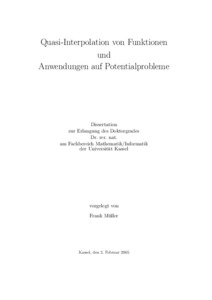| dc.date.accessioned | 2006-05-10T09:40:19Z | |
| dc.date.available | 2006-05-10T09:40:19Z | |
| dc.date.issued | 2005-05-24 | |
| dc.identifier.uri | urn:nbn:de:hebis:34-2256 | |
| dc.identifier.uri | http://hdl.handle.net/123456789/2256 | |
| dc.format.extent | 2126842 bytes | |
| dc.format.mimetype | application/pdf | |
| dc.language.iso | ger | |
| dc.rights | Urheberrechtlich geschützt | |
| dc.rights.uri | https://rightsstatements.org/page/InC/1.0/ | |
| dc.subject | Quasi-Interpolation | ger |
| dc.subject | Potentialprobleme | ger |
| dc.subject | Stokes-Gleichungen | ger |
| dc.subject | Approximationsverfahren | ger |
| dc.subject | Quasi-interpolation | eng |
| dc.subject | Potential theory | eng |
| dc.subject | Stoke-equations | eng |
| dc.subject | Approximate approximations | eng |
| dc.subject.ddc | 510 | |
| dc.title | Quasi-Interpolation von Funktionen und Anwendungen auf Potentialprobleme | ger |
| dc.type | Dissertation | |
| dcterms.abstract | Ausgangspunkt der Dissertation ist ein von V. Maz'ya entwickeltes Verfahren, eine gegebene Funktion f : Rn ! R durch eine Linearkombination fh radialer glatter exponentiell fallender Basisfunktionen zu approximieren, die im Gegensatz zu den Splines lediglich eine näherungsweise Zerlegung der Eins bilden und somit ein für h ! 0 nicht konvergentes Verfahren definieren. Dieses Verfahren wurde unter dem Namen Approximate Approximations bekannt. Es zeigt sich jedoch, dass diese fehlende Konvergenz für die Praxis nicht relevant ist, da der Fehler zwischen f und der Approximation fh über gewisse Parameter unterhalb der Maschinengenauigkeit heutiger Rechner eingestellt werden kann. Darüber hinaus besitzt das Verfahren große Vorteile bei der numerischen Lösung von Cauchy-Problemen der Form Lu = f mit einem geeigneten linearen partiellen Differentialoperator L im Rn. Approximiert man die rechte Seite f durch fh, so lassen sich in vielen Fällen explizite Formeln für die entsprechenden approximativen Volumenpotentiale uh angeben, die nur noch eine eindimensionale Integration (z.B. die Errorfunktion) enthalten. Zur numerischen Lösung von Randwertproblemen ist das von Maz'ya entwickelte Verfahren bisher noch nicht genutzt worden, mit Ausnahme heuristischer bzw. experimenteller Betrachtungen zur sogenannten Randpunktmethode. Hier setzt die Dissertation ein. Auf der Grundlage radialer Basisfunktionen wird ein neues Approximationsverfahren entwickelt, welches die Vorzüge der von Maz'ya für Cauchy-Probleme entwickelten Methode auf die numerische Lösung von Randwertproblemen überträgt. Dabei werden stellvertretend das innere Dirichlet-Problem für die Laplace-Gleichung und für die Stokes-Gleichungen im R2 behandelt, wobei für jeden der einzelnen Approximationsschritte Konvergenzuntersuchungen durchgeführt und Fehlerabschätzungen angegeben werden. | ger |
| dcterms.abstract | Starting point of the thesis is an approximation procedure, called the method of approximate approximations, which was developed by V. Maz'ya. Here a function f : Rn ! R is approximated by a linear combination fh of radial smooth exponential decreasing basic functions. In contrast to linear splines this system of basic functions yields only an approximate partition of unity. Hence the approximation procedure does not converge as h ! 0. For practical computations, however, this lack of convergence does not play an important role, since the error between f and its approximation fh can be chosen to be of the same magnitude as the computer accuracy. Furthermore this procedure has great advantages for the numerical solution of Cauchy problems of the form Lu = f, where L is a suitable linear partial differential operator in Rn. In many cases explicit formulas for the approximate volume potentials can be achieved if the right hand side f is approximated by fh. Often there remains only a one-dimensional integration, for instance the error function. Up to now the method of approximate approximations has not been used for the numerical solution of boundary value problems. Only a few heuristic experimental calculations for the so called boundary point method has been carried out. This is where the thesis starts. Using radial basic functions a new approximation method for the solution of boundary value problems is developed. As in Maz'ya's method an analytic approximation of the solution is obtained. Two model problems are considered, the interior Dirichlet problem for the Laplace equation and for the Stokes system in R2. For every approximation step a rigorous convergence analysis is established and error estimates are given. | eng |
| dcterms.accessRights | open access | |
| dcterms.creator | Müller, Frank | |
| dc.contributor.corporatename | Kassel, Universität, FB 17, Mathematik/Informatik | |
| dc.contributor.referee | Varnhorn, Werner (Prof. Dr.) | |
| dc.contributor.referee | Picard, Rainer (Prof. Dr.) | |
| dc.subject.swd | Potenzialtheorie | ger |
| dc.subject.swd | Stoke-Gleichung | ger |
| dc.subject.swd | Approximation | ger |
| dc.date.examination | 2005-04-22 | |

